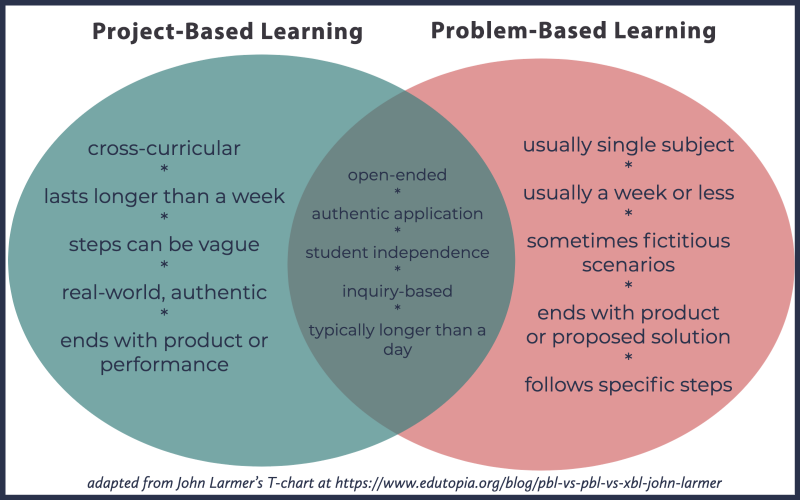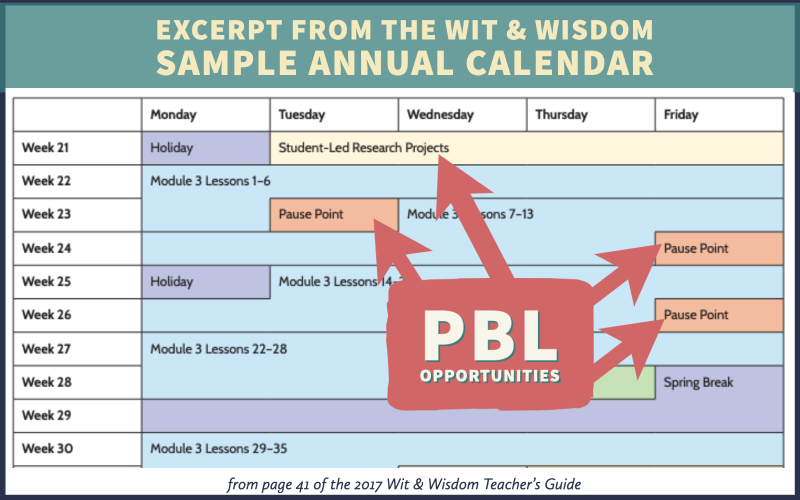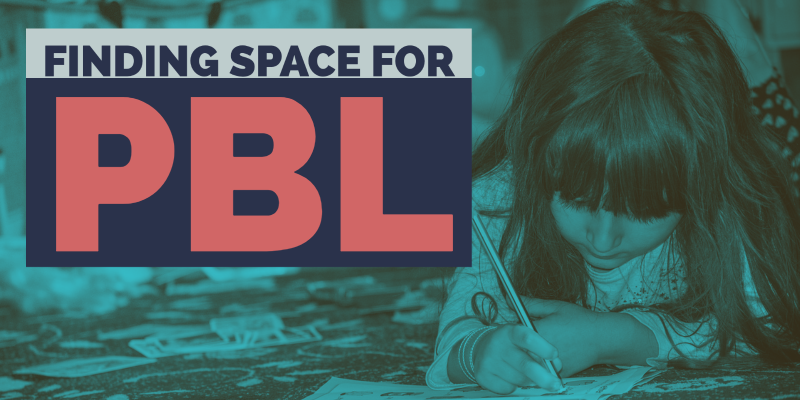How can English Language Arts educators incorporate PBL into scripted or paced curriculum programs without losing the essential aspects of the curriculum? It is a big question, and one in which I am deeply interested as part of an ongoing effort to differentiate and engage students in my classroom with diverse learning styles, skills and interests. But before answering this question, we must first determine whether PBL stands for Project-Based Learning or Problem-Based Learning for the purposes of this examination.
Why not Both?
I often use PBL to refer to project-based learning and problem-based learning interchangeably because they are similar and use the same initialism. The similarity in the fundamental method by which students learn is that “in both models, students are given complex problems with no clear solution and are asked to come up with an original idea” (Lynch, 2017).
But, there are differences and the specific differences vary by the source. Some sources, such as TAG Toolkit, imply that project-based learning allows for greater student control over the topic, saying: “In Project-Based Learning, students have a great deal of control. . .. [but] In Problem-Based Learning, a specific problem is specified by the course instructor” (TAG Toolkit, 2018). Other education leaders see the differences in product, rather than control:
“The main difference between problem and project-based learning is in the product students created. In a problem-based learning lesson, students are simply developing a solution to a problem. With project-based learning, students must extend their ideas and complete an entire project.
(Lynch, 2017)
Problem-Based Learning has two important aspects that make it easier to incorporate into an otherwise PBL-free curriculum: it is shorter and requires less of a time commitment, and it does not necessarily conclude with a project.

While the differences between project-based learning and problem-based learning are important when engaging and planning the specific projects, they are less important for the sake of this discussion, where either variation of PBL would serve as an addition to an existing packaged curriculum. Larmer explains: “the semantics aren’t worth worrying about, at least not for very long. . . both PBLs can powerfully engage and effectively teach your students” (2015).
There is a fairly large online community of educators who use the same curriculum as our district for ELA, Wit & Wisdom, and attitudes among educators in our district about the curriculum are positive. The curriculum provides rigor and research-based teaching. The emphasis on critical thinking seem to align with the critical thinking components of PBL.
The search for examples of PBL incorporated into these packaged curricula results in minimal answers. An informal survey of language arts teachers on a variety of social media platforms, resulted in few affirmative responses. Many teachers found it difficult to maintain the pace of their curriculum without adding additional projects or lessons. Others, didn’t feel comfortable answering. The only positive response I recieved, despite asking in 3 groups, whose members total over 10,000 members (although I am unsure how many are active), was from a middle school principal, who reported that their teachers “take the goal/topic from wit and wisdom and have a PBL that lets them apply the content knowledge they get from the wit and wisdom,” and provided examples that included plant identification and ocean life (Bush, 2021).
Answers Within the Curriculum
The school where I teach uses Project Lead The Way: Gateway, a science curriculum that focuses on engineering. This is a problem-based learning program that emphasizes critical thinking, and student-led learning. However, within our district, there are no attempts at using cross-curricular lessons with PLTW and ELA or Social Studies classes, nor is there an attempt to engage students in ELA and Social Studies using the the skills and processes they learn in their PLTW classes.
A few years ago I attended a training in the implementation of Novel Engineering, a problem based learning program from Tuft’s University, which attempts to bridge the gap between engineering STEM programs and Language Arts learning. Novel Engineering uses existing class books to build in problem based lessons with an engineering focus. However, PBL lessons remain absent from our ELA courses. When I informally polled other educators in teaching support groups, I found that teachers using packaged curriculum were less likely to engage in PBL and cross curricular lesson planning.
I suspect that one of the reasons for this is that the use of packaged curriculums from different companies creates a natural barrier to the blending of curriculum or incorporation of cross curriculum lessons into instruction. It makes sense that programs created by separate companies are not designed to blend with programs created by other, possibly competing, companies.
Furthermore, some packaged curriculums encourage teachers to follow the guidelines closely in order to be effective. Our district’s adopted program allows for some flexibility, however. Wit & Wisdom encourages teachers to “implement the program with integrity,” which they explain means: “Wit & Wisdom is not a scripted program, and Wit & Wisdom instruction will vary from classroom to classroom. While the lessons can be implemented as written, teachers will study the modules and come to know them as deeply as the educators who wrote them. Teachers should use their knowledge of the modules and of their students to customize lessons when needed. . . Optimal learning occurs when teachers strike a balance between flexibility and fidelity,” (Great Minds, 2017).
With this permission to plan with fidelity rather than strict adherence to a script, it is possible that some teachers have found ways to incorporate learning tools such as the design process or open-ended problems into their lesson pacing and if they have found it successful. I am also curious if there are elements of the design process already incorporated into the curriculum that I have not yet considered due to my own unfamiliarity.
Examining the pacing of Wit & Wisdom modules that closely reveals multiple opportunities within the curriculum for problem-based learning, some in which projects are specifically suggested, and for which time is made. There are several pause points within each unit (called a module), and a full week set aside in the sample calendar for student projects.

According to the teacher’s guide, “The time between modules can provide opportunities to extend learning, through activities such as. . . research projects to apply skills and build knowledge” (Great Minds, 2017, pg 40). Further, “Wit & Wisdom can accommodate extra time within modules for teachers to respond to specific student needs” (Great Minds, 2017, pg 41)
The content of lessons also lend themselves to PBL. For example, the overarching themes for the units of this curriculum align with the principles of PBL. For example, module one of the 6th grade curriculum examines the way in which great hardship causes great change with a focus on the Great Depression and the Dust Bowl, and module 2 of the second grade curriculum teaches the erosion of the great plains and the decimation of the American buffalo due to settlement. Both of these studies provide ample room for exploration and problem-solving.
Further, the questions within the module present problems that learners can explore in a student-directed way. The essential question, and others listed in the “examine,” “execute,” “excel,” and “experiment” categories encourage users to respond through critical thinking on both broad and narrow topics. Educators looking to infuse their lessons with PBL can draw from questions, such as “How do I improve characters and context in narrative writing?” which opens opportunities for students to explore characters , or “How do I use technology to produce and publish work,” which encourages students to develop their own writing in a student directed way (Great Minds, 2016, p. 21, 25).
featured image by khamkhor from Pixabay
Resources
Bednar, K. 4 Tips for implementing project-based learning in the classroom. Defined Learning. Retrieved from: https://blog.definedlearning.com/blog/planning-project-based-learning-curriculum
Castelo, M. (2020, August 6). How to facilitate problem-based learning online. Classroom. EdTech Focus on K-12. Retrieved from: https://edtechmagazine.com/k12/article/2020/08/how-facilitate-project-based-learning-online
Dole, S., Bloom, L., Kowalske, K. (2016). Transforming pedagogy: changing perspectives from teacher-centered to learner-centered. The Interdisciplinary Journal of Problem-Based Learning, 10(1). Retrieved from: http://team1cied5363.pbworks.com/w/file/fetch/101934463/Transforming%20Pedagogy_Changing%20Perspectives%20From%20Teacher-Centered%20to%20Learner-Centered.pdf.
Duke, N., Halvorsen, A. (2017, June 20). New study shows the impact of PBL on student achievement. Edutopia. Retrieved from: https://www.edutopia.org/article/new-study-shows-impact-pbl-student-achievement-nell-duke-anne-lise-halvorsen
Great Minds (2021). Knowledge on the go. Retrieved from: https://gm.greatminds.org/en-us/knowledge-for-grade-6
Great Minds (2018). Module 1: Resilience and the great depression. Great Minds. Retrieved from: https://cdn2.hubspot.net/hubfs/3454910/Wit%20Wisdom/Tennessee%20Reviewer%20Files/SE%20Handouts/06.01.Student%20Edition_2017_Clean.pdf
Great Minds (2017). Leading and Supporting School Wide Implementation. Wit and Wisdom Implementation Guide Grades k-8. (pg. 73-74). Retrieved from: https://s3.greatminds.org/link_files/files/000/000/007/original/IG.pdf?1489431853
Kingston, S. (2018). Project Based Learning & Student Achievement: What Does the Research Tell Us? PBL Evidence Matters. 1(1), 1-11. Retrieved from: https://files.eric.ed.gov/fulltext/ED590832.pdf
Larmer, J. (2015, July 13). Project-based learning vs. problem-based learning vs. X-BL. Edutopia. Retrieved from: https://www.edutopia.org/blog/pbl-vs-pbl-vs-xbl-john-larmer
Lynch, M. (2017, August 11). What is the difference between problem, project, and challenge based learning? The Edvocate. Retrieved from: https://www.theedadvocate.org/difference-problem-project-challenge-based-learning/
Miller, A. 21st century literacy skills: designing pbl projects to increase student literacy. DOI: 10.1598/e-ssentials.8060. Retrieved from: http://www.literacyworldwide.org/docs/default-source/member-benefits/e-ssentials/ila-e-ssentials-8060.pdf
Novel Engineering. (2018). Research. [Webpage]. Retrieved from: https://www.novelengineering.org/research/
Planbook. 5 project-based learning tips to add into your lesson plans. Planbook blog. Retrieved from: https://blog.planbook.com/project-based-learning-tips/
Project Lead The Way. (2021). PLTW Gateway (6-8): engaging, exciting, empowering. Retrieved from: https://www.pltw.org/our-programs/pltw-gateway
TAG Toolkit. Problem and project based learning: short and long range projects. Retireved from: https://tagtoolkit.weebly.com/problem–projects-based-learning.html
Taylor. (2017, August 31). How to incorporate project-based learning into your traditional curriculum. Teach.com. Retrieved from: https://teach.com/blog/how-to-incorporate-project-based-learning-into-your-traditional-curriculum/

I really like your approach to “looking for opportunities” where a curriculum can be enhanced with PBL strategies. I shall take a closer look at mine!
I really appreciate that you provided a comparison between Project-Based vs. Problem-Based Learning. I could never quite differentiate between the two. The Venn diagram made it very easy to understand the difference and similarities between both. Thank you!
It was encouraging to read that Wit & Wisdom encourages teachers to “implement the program with integrity.” I’m curious why they’re so much more open to that while others seem so hesitant. Do you think it positively impacts implementation and goodwill from teachers to take that posture?
Since the Wit & Wisdom folks seem so open to flexibility, I went to their website and saw that they do webinars related to implementation. I wonder whether one of those would be a good place for a teacher to ask about PBL? https://greatminds.org/faq/what-support-will-i-receive-from-great-minds-to-help-me-implement-the-wit-wisdom-english-curriculum